SUNDAY
JULY 15 - 2012
Godwits
return
Following news of an
early influx of migrant Black-tailed Godwits, Richard
Somerscocks went looking for them around the local
area, including Pulborough Brooks, Pagham Harbour and
Fishbourne Channel. His best haul was back in Emsworth
Harbour where he counted 72 on the mudflats and he
wondered if this was a record for mid July. In fact,
Godwits regularly return to Emsworth (east harbour) in
mid-July, my record is 97 on 17-Jul-00, though I do
have a number of good counts above 50 at this time of
the year.
Richard got the
following nice shot of a flock of Black-tailed Godwits
flying over Emsworth.
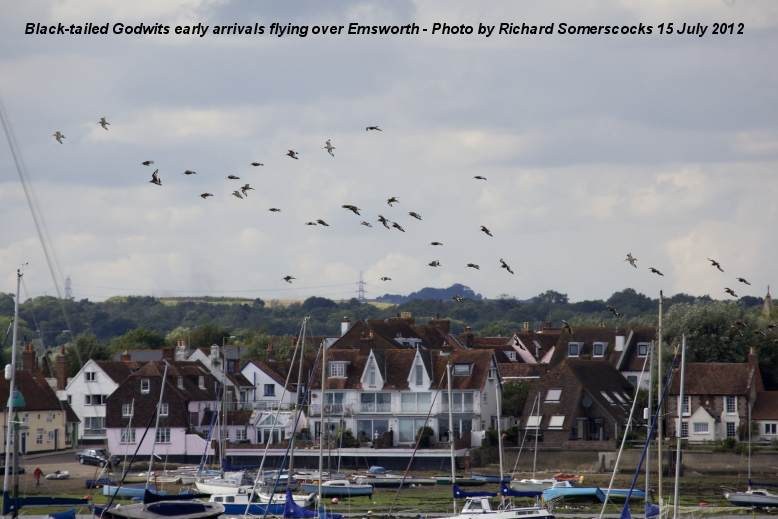
SATURDAY
JULY 14 - 2012
SLIPPER
MILLPOND
17:00 - Following an
afternoon of sometimes torrential rain, I managed to
get out to check the Great Black-backed Gulls on the
Slipper Millpond raft. I was very surprised to find no
less than 5 Cormorants settled quite happily on the
raft in company with the female gull and the two
chicks, both asleep on the edge of the raft. This is
certainly the most Cormorants I have seen there since
the gulls started nesting and clearly indicates a more
relaxed attitude now the chicks have grown to a size
when they are no longer under threat from intruders.
The two chicks are lying down on the left of the
photo.
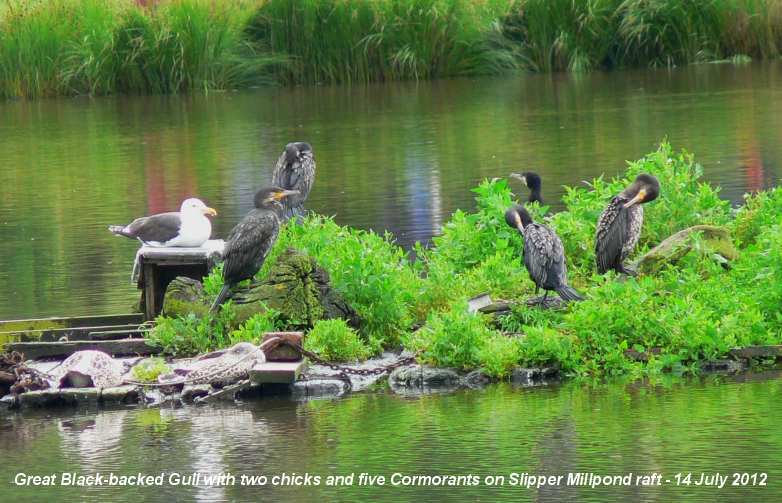
FRIDAY
JULY 13 - 2012
WAYSIDES
NEWS
Annual
Pearlwort
I discovered a small
patch of Annual Pearlwort growing beneath the Beech
hedge on the edge of Bridge Road car park by the
footpath. It can be distinguished from the more common
Procumbent Pearlwort by not having a basal rosette, by
being well branched and by having hairs on the edges
of its leaves.
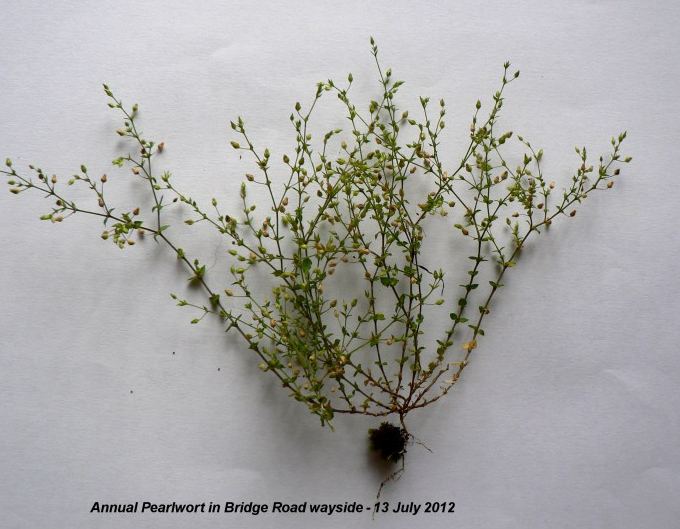
Annual Pearlwort is a
new plant for the Bridge Road Wayside taking the total
for this year to 150 and the grand total to 180.
Annual Pearlwort is also a new plant for the project
taking the total number of plants recorded on the
waysides to 310.
See the full list at .
. . http://www.emsworthwaysides.hampshire.org.uk/few-waysides-plant-list.htm
BROOK
MEADOW
Plants
Newly flowering plants
on the Lumley area included Wild Carrot,
Square-stalked St John's-wort, Red
Bartsia, Blue Water Speedwell (near the
Lumley Stream) and Common Fleabane (almost).
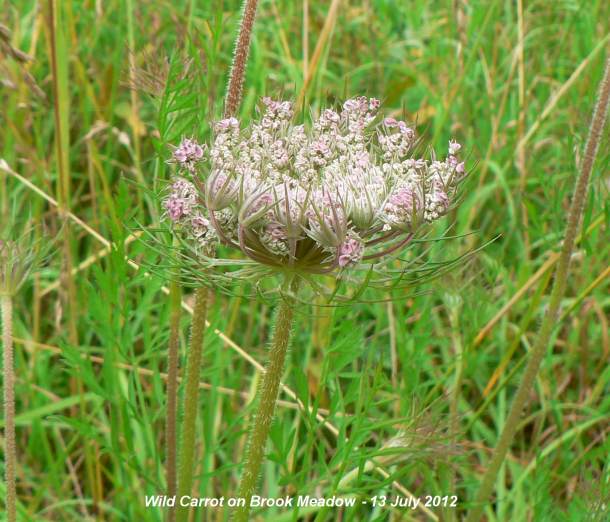
In the Seagull Lane
area a buttercup with reflexed sepals near the
southern planted Oak (the Mayor's) is probably
Hairy Buttercup but I did not dig it up to find
out for sure! However, there is another one at the far
end of the Jubilee hedge.
Black Horehound
is now flowering particularly well along the extension
of Seagull Lane towards the railway arch, probably the
best I have ever seen it on the Brook Meadow site. One
can see both Giant Fescue and Gipsywort (not in
flower) beneath the south bridge (to the south west).
Common Couch
(mostly with awns) is growing well on the path around
the Lumley area and on the small path down to the
Lumley Stream.
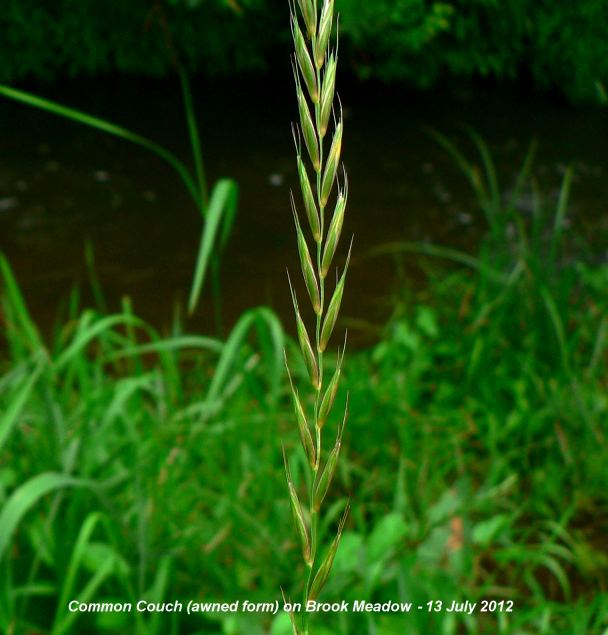
Sharp-flowered
Rush is showing very clearly on the cross path to
the west of the Lumley area.
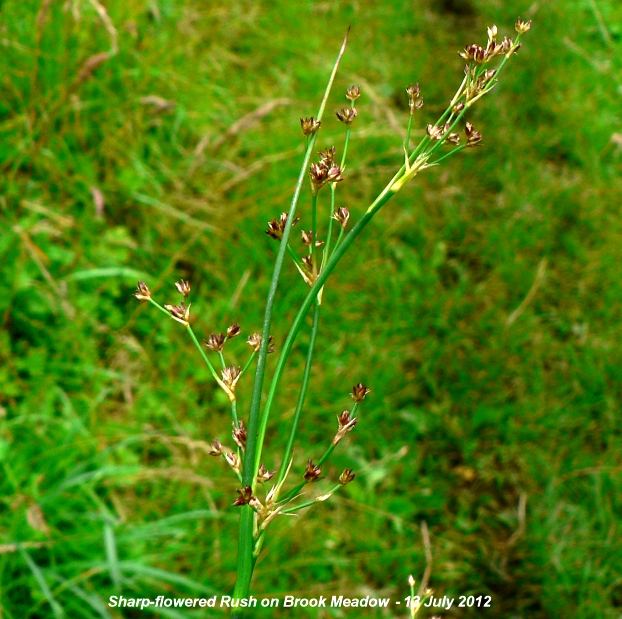
There is no sign of
the Broad-leaved Everlasting-pea which has been a
regular on the Seagull Lane patch for many years.
Likewise, there is no sign of the Marsh Woundwort at
the top of the Bramble path. I also looked hard for
Meadow Barley but I still have not seen any on the
meadow this year. Has anyone?
Birds
All three of our
summer visitors were singing on the meadow this
morning, Whitethroat, Blackcap and Chiffchaff, but
very little else.
Insects
I disturbed a number
of brown butterflies, which I assume were mostly
Meadow Browns. I did not pursue them. Red Soldier
Beetles are now gathering on the flower heads of
Hogweed, waiting for prey.
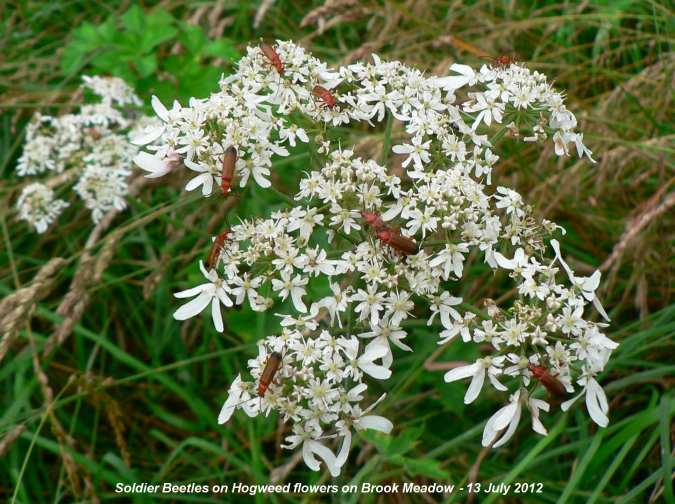
TUESDAY
JULY 10 - 2012
SLIPPER
MILLPOND
The two Great
Black-backed Gull chicks were on the centre raft
with one of the parents in the water nearby. They were
looking strong and healthy. I was 'buzzed' briefly by
the adult gull as I was watching from Slipper Road. A
Reed Warbler was singing from the bushes nearby as it
was on Sunday.
The Coot
remains well established in its nest box on the north
raft, but there is no sign of the three chicks that I
saw there on July 7. Presumably they were taken by the
gulls.
The magnificent
Strawberry Tree which has been such a feature
on the east bank of the pond is dying. It has lost all
its leaves and looks in a very bad state. The same has
happened to the Strawberry Tree in the garden of
Tenerife Cottage in Bath Road.
PETER
POND
Better news Coots on
Peter Pond where a family with four chicks was seen
yesterday by Brian Lawrence. They were still there
today, surprisingly, on the side of the pond in front
of the seat being fed by passers-by. I do not recall
ever having seen a Coot family on the pond side
before. Also, on Peter Pond was a female Mallard with
two ducklings, down from three on July 6.
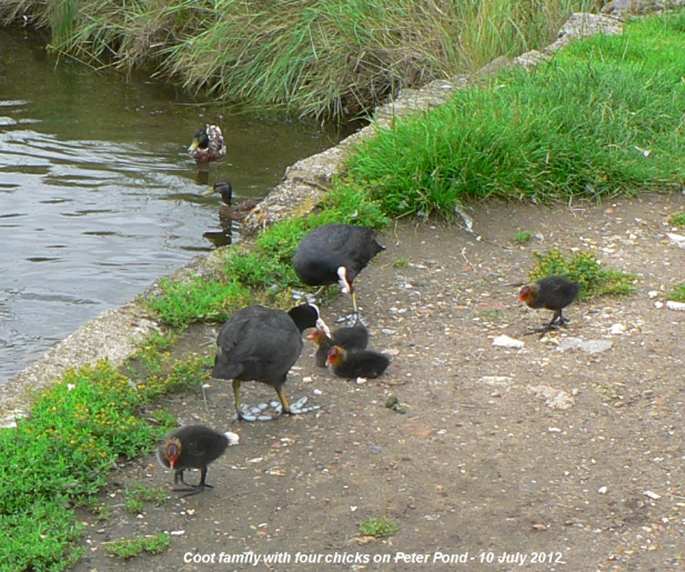
Hedge Bedstraw
and Perennial Sow-thistle are both in
flower for the first time on the east side of Peter
Pond.
MONDAY
JULY 9 - 2012
WAYSIDES
SURVEYS
Jane Brook and I
continued our weekly surveys of the waysides after a
couple of weeks off due to bad weather. We started at
Washington Road path and went over to the Emsworth
Recreation Ground before cutting across to the
Christopher Way path and verge. Finally we cut back to
the New Brighton Road Junction. It was a very
successful morning's work with several additions to
the plant list of each wayside and three totally new
wayside plants, Marsh Woundwort, Common Oat and
Enchanter's Nightshade, taking the grand total to 309.
We also found Meadow
Barley and Marsh Foxtail on the Emsworth Recreation
Ground and Black Bent-grass on the New Brighton Road
Junction.
Details and photos are
on the waysides web site . . . http://www.emsworthwaysides.hampshire.org.uk/few-NEWS-current.htm
Bridge
Road Wayside
I had another close
look at the evening primrose flowering on the Bridge
Road Wayside (south verge), which I thought might be
Common Evening Primrose. However, I am now fairly
confident (!!) that the plant is the more common
Large-flowered Evening Primrose.

It does in fact have
the required the red glandular hairs on the stems. I
cannot understand how I failed to see them yesterday.
The styles in the flowers are also longer than the
stamens supporting the Large-flowered identification.
However, the petals are green and not red striped as
they should be for Large-flowered.
SUNDAY
JULY 8 - 2012
SLIPPER
MILLPOND
Great
Black-backed Gulls
15:30 - I just arrived
in time to see one of the Great Black-backed Gull
chicks swimming around the raft, much as Janet Baker
did yesterday. Both parents were on the raft keeping a
wary eye on their youngster, but it was doing fine.
After a few minutes the chick scrambled back onto the
raft and flexed its now impressive wings. Also, on the
raft were two Cormorants which are clearly well
tolerated by the gulls.
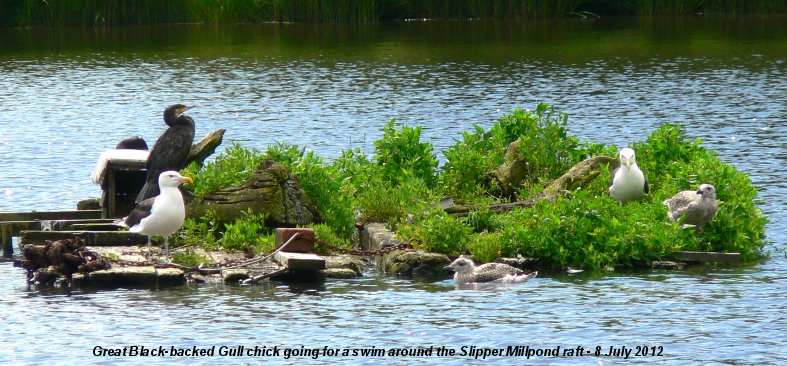
Coot
nest
I could see the Coot
in the nest box on the north raft, but there was no
sign of the three chicks that were there yesterday. It
is possible that they were hiding in the nest, but
when the other parent came to the raft with food only
the adult Coot came out to take it. This looks ominous
that the chicks were taken by the gulls.
BROOK
MEADOW
Richard Somerscocks
reports: "There was plenty to see on the meadow this
morning with the sun out, although it is incredibly
wet underfoot at the moment. No new butterflies noted
but a good selection of Meadow Browns, Red Admiral,
Commas, Ringlets (including 2 mating), Marbled White,
Large White, Holly Blue, Large and Small Skipper.
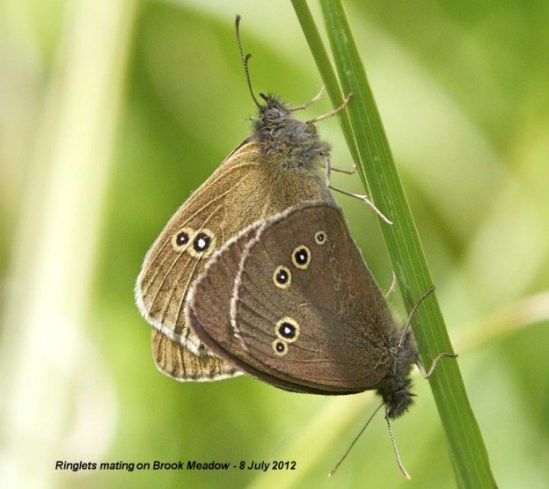
HOLLYBANK
WOODS
Richard went to
Hollybank Woods this afternoon. "The sun had gone in
and after a short while it started to rain, so there
was not much to see to start with. Luckily the sun
came out after a while and I managed to see a couple
of White Admirals so they are obviously around.
A visit on a good sunny day would probably be more
productive.
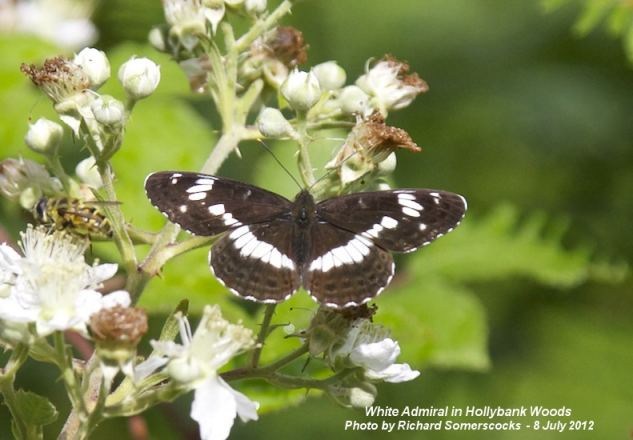
Other butterflies seen
included the Silver-washed Fritillary and many of the
same varieties as seen on Brook Meadow. In the
clearing near the centre I also saw a white version
of what I assume was a Musk Mallow - there were
some pink flowers nearby, which is the normal
colour"
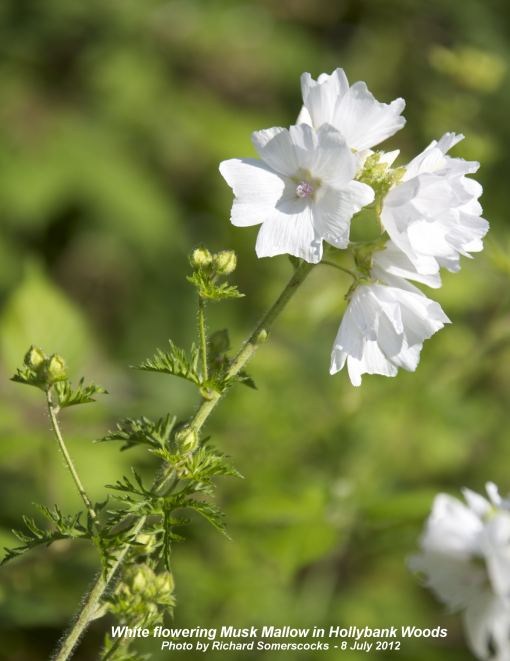
EVENING
PRIMROSE
I have been puzzling
over a mystery plany on the Bridge Road Wayside, but
it has fianlly flowered and revealed itself as an
Evening Primrose. But which one? This plant does not
have the red based hairs on the stems or the red
striped sepals, so that rules out Large-flowered
Evening Primrose which is the most common species. The
green sepals and flat leaves with red midrib suggests
the less frequent Common Evening Primrose (Oenothera
biennis).
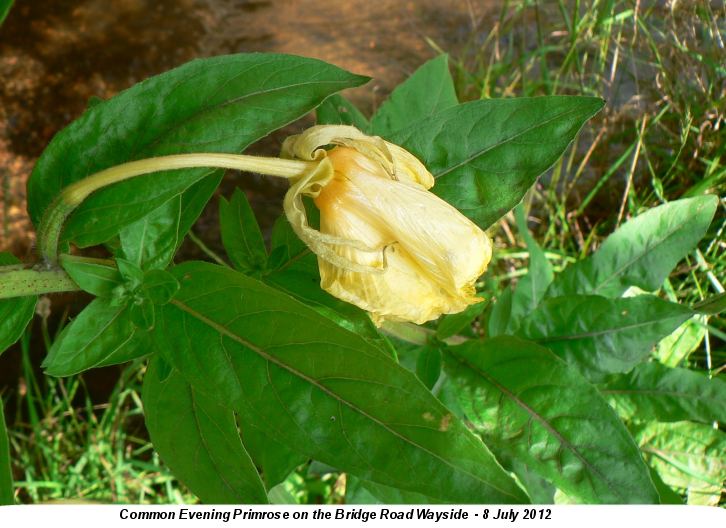
SATURDAY
JULY 7 - 2012
Great
Black-backed Gull chick goes for a swim
Janet Baker, whose
house overlooks the gull raft on Slipper Millpond
reported that one of the chicks took to the water at
8am this morning. "Accompanied by much mewing from the
watching parent - it did several circuits of the raft
- tried to get back on, but flapped and failed - did
another lot of circuits and remounted the raft to
'safety'. The adult bird followed the chick round and
round keeping an eye on it! Wonderful to watch. The
other chick kept looking at the water and getting
close but has not yet - as far as we know - made the
plunge. I hope it jumps in when the tide is still high
- as it might have a bit of a job getting back on to
the raft afterwards!"
No
sign of Grey Partridge family
Richard Somerscocks
went down to Thorney Deeps again this morning during a
dryish spell to look for the Grey Partridge family
that he saw yesterday, but there was no sign of them.
There were quite a lot of people exercising dogs so
they were long since gone. Richard wonders what
happened to the chicks which were trapped between the
harbour wall and the canal. In the harbour opposite
Little Deep there were a couple of Black-tailed
Godwit.
Meanwhile, at home,
Richard has had a Fox sheltering outside his kitchen
window for almost the entire day.
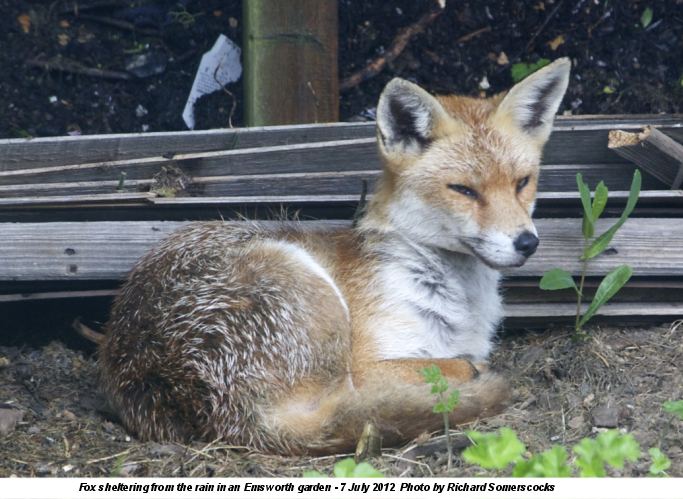
Mating
Bumblebees identified
- Bombus hypnorum
I sent the photo of
the two Bumblebees mating that my son took on his
garden patio yesterday to entomologist Bryan Pinchen.
Bryan said the excellent photo was of two Bombus
hypnorum - ginger thorax, black abdomen, white tail
tip.

"Like many insects
they will often fly when still attached if they are
disturbed. However, it is a rare thing to see, and I
have only witnessed Bumblebees mating on two
occasions. It was a good sighting and a sign that at
least one Bumblebee nest has succeeded this 'summer'
when generally numbers have been well down
everywhere."
Ralph Hollins also
provided the correct identification of the Bumblebees
and suggested the following web site for more
information on Bombus hypnorum (Tree Bumblebees).
http://www.opalexplorenature.org/TreeBumblebee
Interestingly,
although they are recent invaders to this country,
Tree Bumblebees are causing no harm to our native
bumblebees or other wildlife. They are also great
pollinators, supporting our plant populations at a
time when some other bumblebees are declining in
numbers.
FRIDAY
JULY 6 - 2012
EMSWORTH
NEWS
Great
Black-backed Gull family
16:30 - When I arrived
at Slipper Millpond this afternoon, the female Great
Black-backed Gull was sitting on top of the now empty
Coot nesting box on the centre raft with one chick
standing beside her and the other chick on the other
side of the raft. Two Cormorants were also on the
island, presumably after fishing, but were not
attracting any attention from the resident gull. The
two chicks are now developing the neat black and grey
mottled plumage of a typical juvenile, as shown in
this photo taken this afternoon by Richard
Somerscocks. I saw them both flexing their wings.
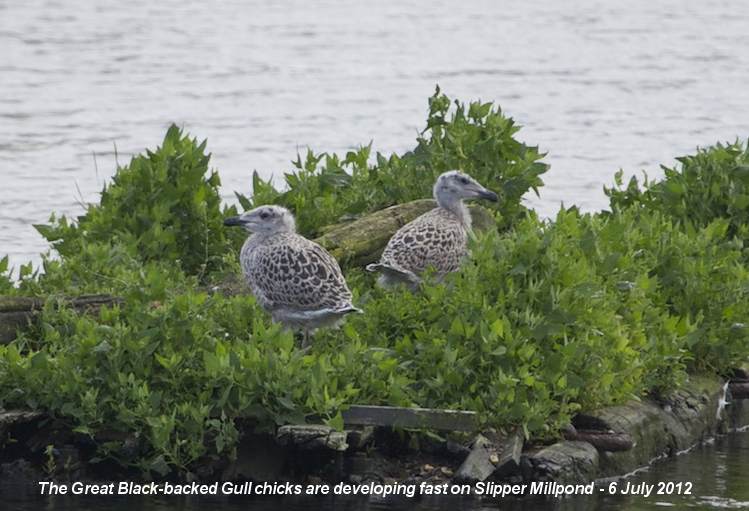
New
Coot family
One new development on
Slipper Millpond was the appearance of three Coot
chicks on the north raft. The chicks were clearly
only a few days old and were being fed by their
parents on the raft. We shall see how long they
survive in such close proximity to hungry Great
Black-backed Gull chicks.
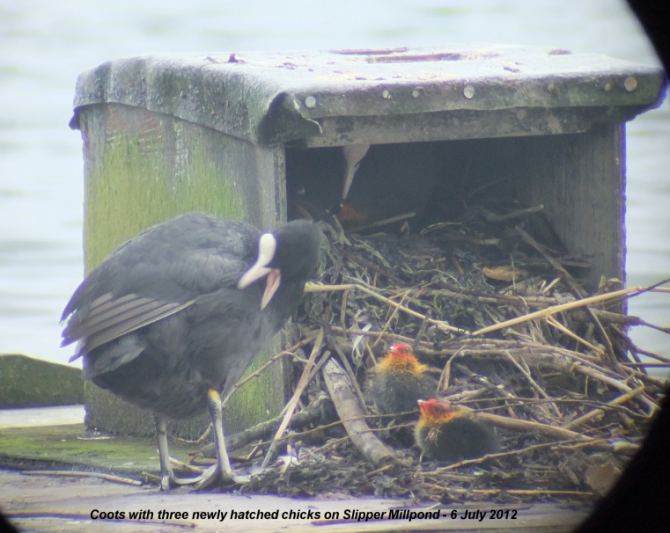
Mallard
family
The Mallard family
with three small ducklings that I saw earlier in the
week is still present on the pond, presumably out of
sight of the large gulls on the adjoining pond.
Grey
Partridge family
Richard Somerscocks
went down to Thorney Deeps this afternoon. As he
walked along the western path, two Grey Partridge flew
up a few feet away from him, taking him by surprise.
Richard got the following shot of one as they flew
over the channel and into the field on the other side,
where they disappeared from view. Looking at where
they had got airborne from and he could see 4 or 5
very small chicks scurrying away into the undergrowth.
This is worrying as this path is well used by people
with dogs and the small birds can't get away from the
path because the channel stops them getting into the
field.
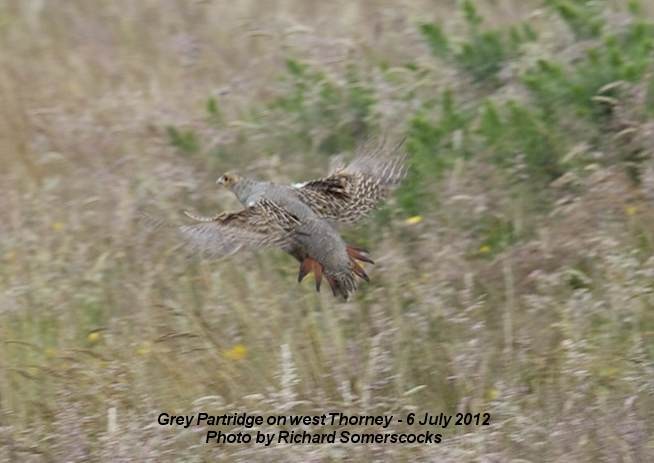
Waysides
News
Shaggy Soldier is
flowering in the same place as it did last year -
namely along the roadside kerb on the west end of the
island at the bottom of Queen Street - right opposite
the entrance to the Lillywhite's path wayside.
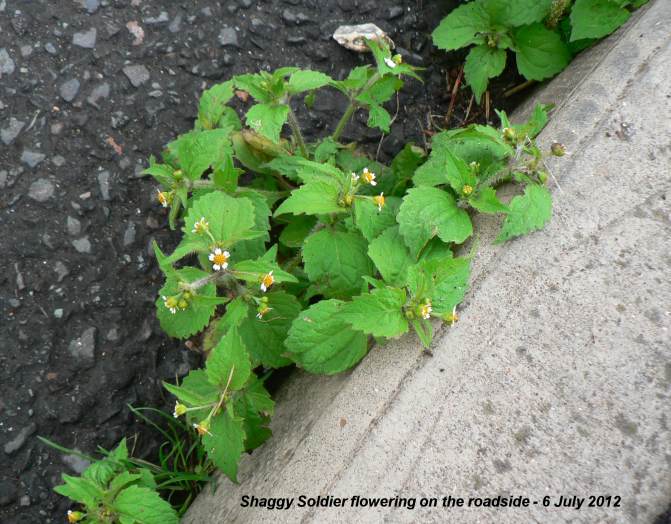
Bumblebees
mating
My son, Danny sent me
a very interesting photo of bumblebees mating on his
garden patio in Emsworth. He said they flew off a few
feet, still stuck together, when he and the kids got
too close. Personally, I have never seen bumblebees
mating and I gather it is not commonly observed, so
they were very fortunate to witness such an
interesting natural event.

The bees were probably
of the species Bombus pascuorum, which
is the most widespread ginger-coloured bumblebee in
this country, occurring in most habitats including
gardens. I will check with expert Bryan Pinchen. The
larger queen is on the right of the photo and the
smaller male on the left. The queen is about 17mm and
the male 13mm. These two are likely to be newly
emerged male and queen bees, which come out from
mid-July onwards.
The adult male
bumblebee has only one function in life which is to
mate. He will fly in a circuit depositing a
queen-attracting scent in suitable places, usually in
the morning, and replacing the scent if it rains. New
queens emerge about a week or so after the males. The
new queens leave the nest to forage for themselves.
When she is ready to mate she flies to where the
attractant chemical has been deposited by the male and
waits for a suitable mate. Queens generally mate only
once.
Bumblebees form annual
colonies and only mated queens will survive the winter
to start new colonies in the spring. The nest is often
in underground holes and is basically a ball of grass
and moss with wax cells inside it. The young are
reared on pollen and nectar carried home by the
workers in pollen baskets on their back legs.
As for the mating
process itself this usually takes place while resting
on the ground or on vegetation. Mating bees are
sometimes seen flying still attached to each other,
presumably when they are disturbed, as they were in my
son's garden. The time taken for mating varies widely
from 10 minutes to 80 minutes. The sperm is
transferred within the first 2 minutes of mating.
After the male passes his sperm into the queen he
pumps a sticky mixture into her genital opening, which
when hardened can completely or partially block the
entry of sperm from other males. So, even though this
lengthy mating period makes the two bees vulnerable,
it is in the interest of the male to hang on to ensure
that his genes have a good chance of being passed on
to the next generation.
Most of this
information came from . . . http://www.bumblebee.org/lifeMate.htm
Turtle
Dove concern
The latest Breeding
Birds Survey report from the British Trust for
Ornithology - http://ctt-news.org/NXN-USNN-3GJW16-BZ65U-0/c.aspx
- reveals that the Turtle Dove population has suffered
a 69% decline since 1980; such is the level of concern
amongst conservationists, it is now the focus of a
special project, Operation Turtle Dove -
http://ctt-news.org/NXN-USNN-3GJW16-BZ65V-0/c.aspx
. We do not appear to have had a Turtle Dove in
Emsworth this year or even on Thorney Island where
they are usually regular summer visitors.
THURSDAY
JULY 5 - 2012
BRIDGE
ROAD WAYSIDE
I spent a couple of
hours on the Bridge Road Wayside this morning checking
the plant list for anything new and doing a litter
pick.
Plants newly flowering
since the last survey included Butterfly Bush,
Hollyhock, Vervain, Water Figwort, Common Knapweed,
Corn-cockle, Narrow-leaved Water-plantain, Toad Rush,
Hairy Buttercup.
I had my first
Gatekeeper of the year. At least four Swifts have been
flying around the houses in Bridge Road today.
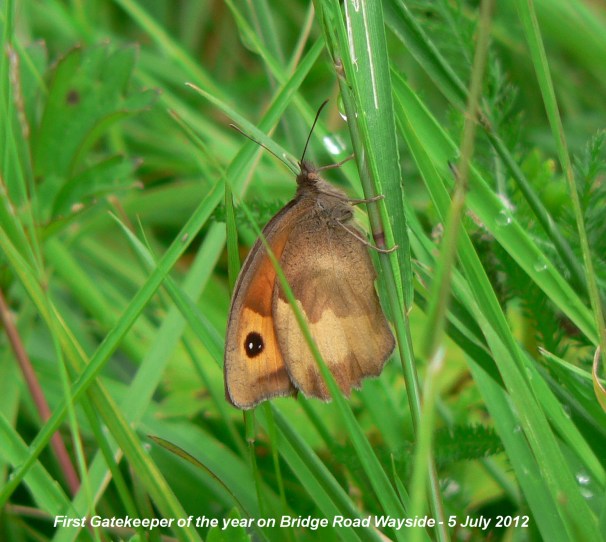
The full report with
photos is on the waysides web site at . . .
http://www.emsworthwaysides.hampshire.org.uk/few-NEWS-2012b.htm
BROOK
MEADOW
Richard Somerscocks
found plenty of butterflies on Brook Meadow on a warm
afternoon, the most he has seen this year. Sightings
included Meadow Browns, quite a few fresh Commas, Red
Admirals, Ringlets, at least 3 Marbled Whites and
Large Skippers.
Richard also had Small
Skipper for the first time this year on Brook Meadow.
He looked on the Hants and IoW Butterfly Conservation
site and couldn't see Small Skipper recorded for
Hampshire so he submitted a report.
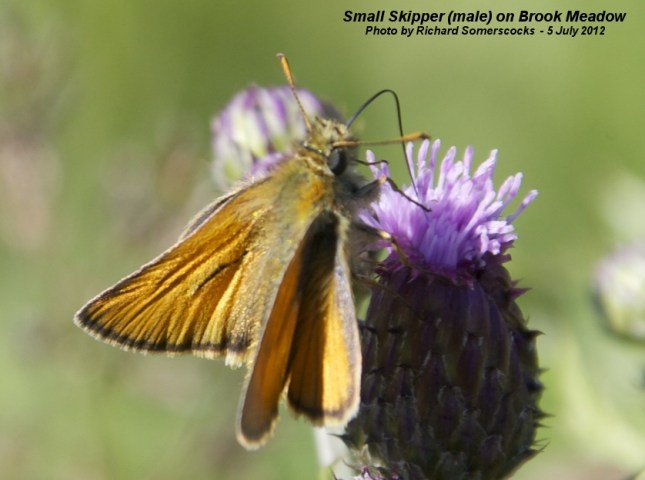
Banded Demoiselles
were also around, as well as Azure and Blue-tailed
Damselflies.
SLIPPER
MILLPOND
Richard found the
Great Black-backed Gulls peacefully co-habiting the
raft on Slipper Mill Pond with the Cormorants on his
way home. That chick is certainly growing, but where
is the other one? I have not seen it recently. But
Richard saw them together a little later this evening.
Despite their growing size they can be difficult to
see amongst the vegetation at times.
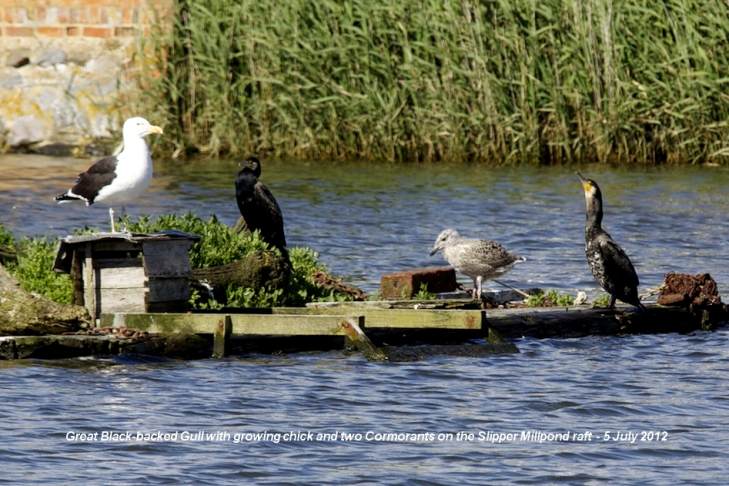
WEDNESDAY
JULY 4 - 2012
BROOK
MEADOW
I donned my wellies
and had a good mooch around the meadow this morning. I
started in the Seagull Lane patch where I had a look
along the path leading to the railway arch where I
found a good growth of Stone Parsley though not yet in
flower. A plant which often does not flower is
Black Horehound but there is a lot of it along
the edge of the Seagull Lane patch with whorls of pink
flowers and tunnel shaped sepals.
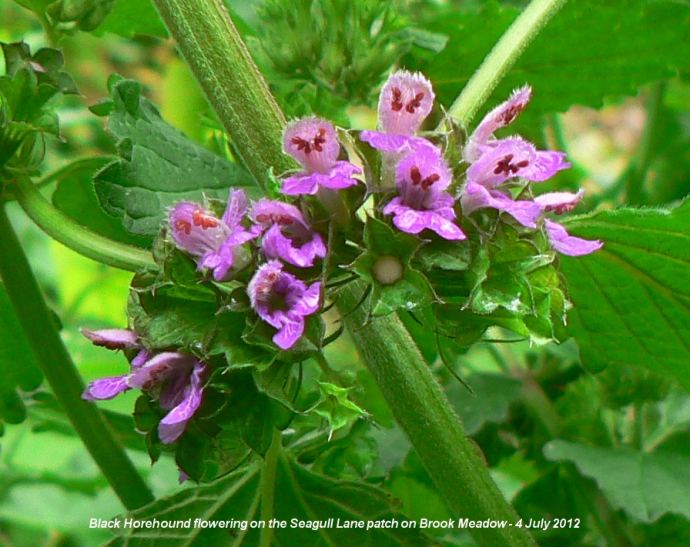
The Fool's Parsley
on the recently cleared area by the hedgerow is
now showing flowers and thin bracteoles hanging down.
There is a lot of Amphibious Bistort on the Seagull
Lane patch, but no flowers.
I was very pleased to
discover a single plant of Hairy Buttercup at
the far end of the hedgerow line. It had reflexed
sepals and as the ground was very soft, I was able to
prise the plant up with my penknife to reveal normal
roots and no bulb. I planted the plant back in the
ground without any problem and it should be OK.
Hedge Bindweed
is flowering on the north path. There is a good growth
of what looks like Male Fern on the railway embankment
side of the north river. Hogweed is flowering
well on the north meadow with mainly white umbels, but
sometimes pink. Yellow flowers are starting to show on
the Square-stalked St John's-wort on the orchid
area. There is a good display of Meadowsweet in
flower on the north east path. It is good to see the
Jointed Rush again in flower on the north east path
south of the small seat.
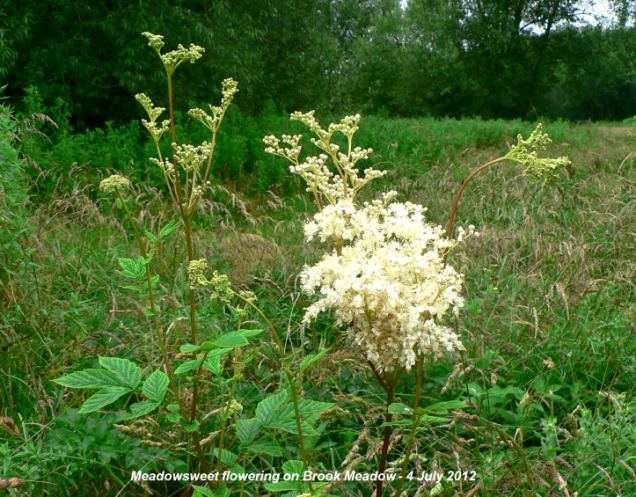
Marsh Foxtail
is flowering well in the "Lumley puddle" - the only
place on the meadow that it grows.
Birds
Birds heard singing
this morning included Whitethroat, Blackcap,
Chiffchaff, Wren, Song Thrush, Blackbird, Woodpigeon,
Collared Dove, House Sparrow.
Damselflies
I had a splendid male
Banded Demoiselle on the Seagull Lane patch
which I could not resist taking a shot of. An Azure
Damselfly was flying near the "Lumley puddle".

Butterflies
Tony and Hilary
Wootton had a fruitful half hour on Brook Meadow
during a burst of warm sunshine this afternoon. They
saw lots of butterflies, including Red Admiral, Meadow
Brown, Large Skipper, Marbled White, Comma and
Ringlet.


A
YEAR IN THE LIFE OF CHRISTOPHER WAY VERGE
WAYSIDE
Juliet Walker has
created a fine series of images showing the changes in
the Christopher Way verge wayside throughout the year.
Juliet's images are on the Christopher Way verge page
at . . . . http://www.emsworthwaysides.hampshire.org.uk/wayside-14-christopher-way.htm
TUESDAY
JULY 3 - 2012
Slipper
Millpond
15:30 - One Great
Black-backed Gull was on the pond near the raft. I
could only see one chick on the raft, but the
vegetation is now so lush that I suspect the other
chick was snuggled down somewhere out of sight.
The Coot nest
on the southern raft has been abandoned. A Coot has
been settled on the raft for a few weeks and I did see
some eggs in there about a week ago. However, there is
no sign of eggs, chicks or adults - though I suspect
the latter are hiding away in the reeds. The Great
Black-backed Gulls are the obvious suspects. The Coot
is still settled firmly behind its barricade of twigs
on the north raft.
However, there was no
sign of the Coot family with two chicks that I saw on
the Peter Pond raft on July 2. The best we can hope is
that the parents took the chicks into the reeds,
though I fear they may have been discovered by the
gulls.
Herring
Gull nest
Marion Emberson has
been enjoying watching a Herring Gull family nesting
on the roof of no 50 Selangor Avenue. Marion first saw
two chicks 2-3 weeks ago, standing on the flat porch
roof. Since then they have wandered over the roof,
sometimes retiring behind the chimney again. Marion
says there is always an adult on the roof and when the
chicks first appeared the adult flew at her when she
stopped to look. Interestingly, this 'buzzing' also
happened to me when I watched the Great Black-backed
Gulls on Slipper Millpond. The larger chick is now
showing its first proper wing feathers, but flight is
unlikely for another 2-3 weeks as fledging is 35-40
days after hatching.
I went up this
afternoon to have a look for myself and take some
photos. While I was there a lady passed by saying
'Have you come to see our seagulls?' She explained
that several neighbours had been enjoying the
spectacle of the young developing and were looking
forward to them fledging.
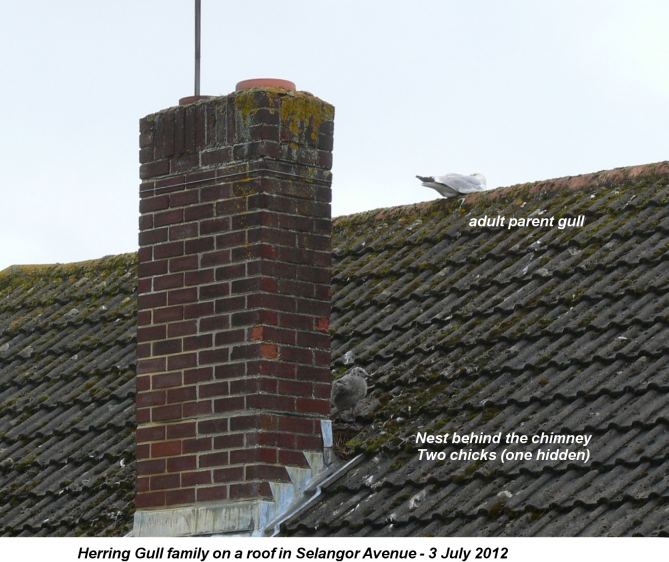
MONDAY
JULY 2 - 2012
BROOK
MEADOW
Following a
communication from Maurice Lillie about the 'new'
plants coming up in the recently cleared ground on the
Seagull Lane patch, I had a quick look today. I found
the usual mass of Lesser Swine-cress and Scented
Mayweed along with a number of large plants of Prickly
Lettuce and a single Fat Hen. Interestingly, I also
noted several new plants of Fool's Parsley which I had
not seen before; they were not in flower, but were
showing the distinctive thin bracteoles hanging down
from the developing umbels. I have previously recorded
Fool's Parsley in this area, so the clearance work has
helped the plants to spread.
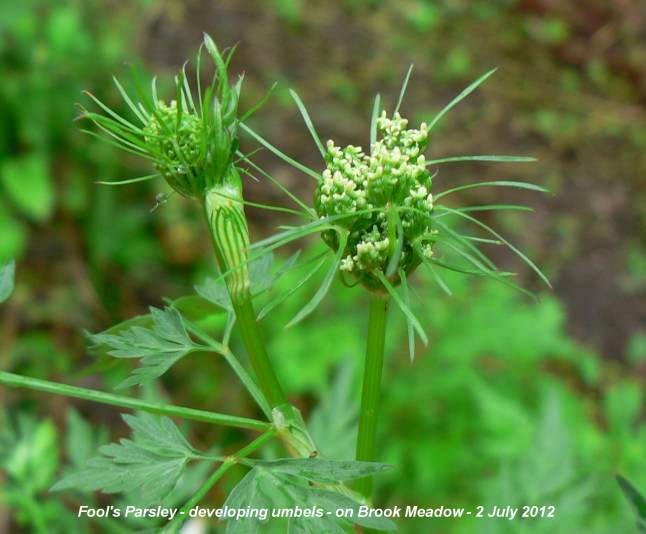
MILLPOND
NEWS
The Coot nesting
on the new raft on Peter Pond has hatched at least
two chicks. Let's hope the Great Black-backed Gulls
nesting on the adjacent Slipper Millpond do not
discover them. I have never seen the Great
Black-backed Gulls on Peter Pond, but I would not be
surprised if they were discovered.
The male Great
Black-backed Gull was on Slipper Millpond with the
chicks on the raft. I was 'buzzed' again by the gull
while I was watching the raft from Slipper Road; the
gull swooped low over my head, closer than it has ever
been before. A little scary! While the gull was
buzzing me a Cormorant which had been fishing in the
pond got up onto the raft, but did not attract the
attention of the gull.
Isle
of Wight cemetery
Jean and I were on the
Isle of Wight on Sunday, during which we had a walk
around Northwood Cemetery in Cowes. I had been there
before, but not in 'summer' so I previously missed the
splendid areas of wild grassland, with lots of
flowers, including Common Spotted Orchids and lots of
Corky-fruited Water-dropwort. Walking through the
grasses we put up lots of Meadow Browns and a few
Marbled Whites.
I was most pleased to
see Common Cow-wheat in flower, not a plant I
was expecting as it is not at all common locally.
However, it is common in the north of the Isle of
Wight - eg in Parkhurst Forest.
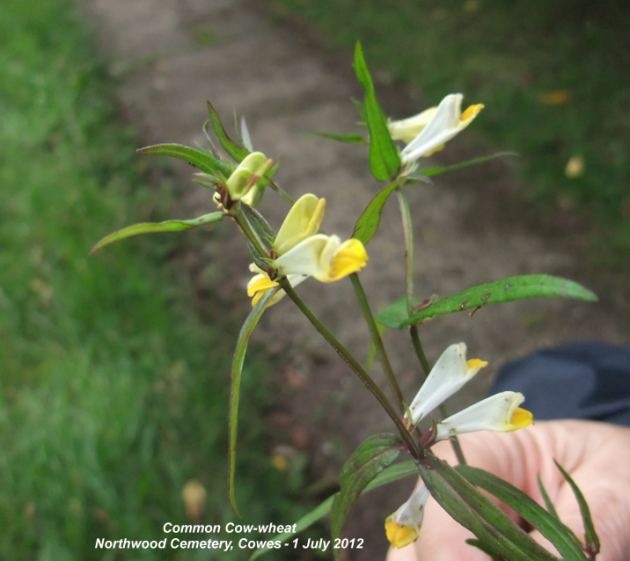
LANGSTONE
HARBOUR REPORT
Chris Cockburn has not
good news from Langstone Harbour.
At the Hayling
Oysterbeds, stage 1 of breeding season is coming
to an end with c80 black-headed gulls youngsters from
the original 1039 nests. Stage 2 is now underway with
c100 Black-Headed Gull pairs apparently nesting, most
of them presumed to have lost their first clutch due
to tidal flooding.
There are currently
four Common Terns apparently on eggs and at least five
pairs prospecting for nest sites. Their main problem
is that many failed black-headed gull pairs are still
acting territorially, especially over the high tide
period - this behaviour is deterring common terns from
settling. If all goes well, the breeding season will
now extend into August, possibly even September! No
Sandwich or Little Terns are nesting but two pairs of
oystercatchers are firmly ensconced. Mediterranean
gulls are occasional visitors to the site but, like
foraging large gulls, must be disappointed at the lack
of tasty chicks. Hopefully, the Meds at least will
have left the harbour before any common tern chicks
are hatched.
The series of spring
tides from 04 to 07 July pose the biggest potential
threat if this year's pattern of tidal surges
continues, so much crossing of fingers. Visible insect
activity is still low in spite of lush vegetation -
very disappointing now that many of the summer
butterflies should be flying (e.g. only a few Marbled
Whites have been seen so far)
It has not been
possible to closely monitor the colonies on the
harbour's islands, but the unusually frequent
unsettled behaviour of the birds implies that 2012
will be a season of low productivity. Recent views of
Baker's Island from Farlington Marshes suggest that
there are no longer any active nests of gulls, little
terns, oystercatchers or ringed plovers. Given that
there have been no flooding tides recently, mammalian
or avian predation might be the cause but the strong
winds & wet spells have not been beneficial. The
summering flock of bar-tailed godwits are still in the
harbour and the numbers of roosting curlews is rapidly
increasing.